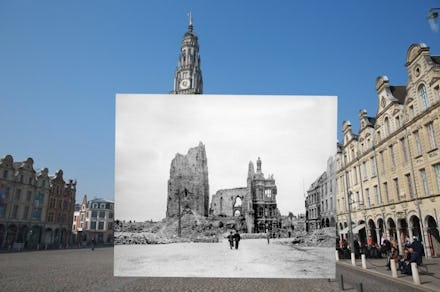Haunting Google Images Remind Us What Europe's Most Vibrant Cities Once Looked Like

Just watching Saving Private Ryan doesn't really do justice to the horrible damage that World War II did to Western Europe. And even fewer Westerners remember the scale of the carnage of World War I, overshadowed as it was by the brutal German-Soviet Eastern Front and mass-murder of Jews, Poles, and other "undesirables" by Nazi forces of World War II.
But thanks to Google Images, you can now see how both of these devastating wars would play out in the modern world. The Guardian's Halley Docherty covers Europe during World War II, while photographer Peter MacDiarmid took on World War I.
The 17 images are a stark reminder that what happened during the first half of the last century must never happen again.
1. Place des Heros, Arras, France
The town hall and belfry of Arras was completely annihilated, reduced to a burned-out shell and a stump of a tower after intense fighting.
2. In London on Oct. 14, 1940, London's Balham station civilian air raid shelter stands in ruins during the Blitz.
Sixty-eight people were killed by the blast, with more than 70 injured. The damage was quickly repaired and the station was reopened by Jan. 12, 1941.
3. Yes, that's a bus being pulled out of the same crater.
4. France bombarded near Rheims Cathedral, April 30, 1917.
The cathedral took direct hits during the war, causing the lead of the roofs to melt and fire to burn out most of the building's interior. It was restored from 1918-1938.
5. Nazi soldiers parade down the Champs-Elysées in Paris, June 1940.
The Nazi-installed Vichy regime killed an estimated 77,500-90,000 French Jews from July 1940-August 1944.
6. Les Halles in the Grote Market, Ypres, Belgium
Three major WWI battles nearly annihilated Les Halles in an area of Ypres that now attracts tourists and shoppers.
7. Horse-mounted Nazi soldiers triumphantly march down Arc de Triomphe onto Avenue Foch.
For more on the Nazi occupation of Paris, see this collection of propaganda photos from photographer Andre Zucca, who the New York Review of Books' Ian Burman described as "... not a Nazi, but he felt no particular hostility to Germany either ... Zucca simply wanted to continue his pre-war life, publishing pictures in the best glossy magazines. And the one with the glossiest pictures, in fine German Agfacolor, happened to be Signal, the German propaganda magazine."
8. A bridge connects two sections of Warsaw's infamous Jewish ghetto in 1942.
In 1944, the Polish resistance's Home Army attempted to liberate Warsaw from Nazi control. Fighters hoped to oust Nazis at the same time as Soviet forces arrived to evict German forces from the city. The USSR's troops didn't arrive — perhaps intentionally — and 16,000 or more members of the Polish resistance were killed. Over 150,000 Polish citizens were liquidated in mass executions, and an additional 700,000 fled the city.
9. What Hiroshima looked like in August 1945
Pictured are the ruins of the Prefectural Industrial Promotion Hall that survived the atomic blast on Aug. 6, which still stand as part of the Hiroshima Peace Memorial. An estimated 90,000-166,000 people were destroyed instantly or died painfully from radiation over the next 2-4 months, from a pre-attack population of 340,000-350,000.
10. Giant poster of Stalin in Russian-occupied Berlin, June 3, 1945
The Battle of Berlin was one of the most bitter battles in all of World War II, with 92,000-100,000 German soldiers killed, 81,116 dead or missing Soviet troops — with 22,000 German military and 22,000 civilians slaughtered inside the Berlin Defence Area.
Over 125,000 civilians are estimated to have been killed during the entire operation to retake Berlin. Vengeful Soviet troops engaged in mass looting, rape and indiscriminate murder during the early days of the occupation.
11. German airplanes at Place de la Concorde in Paris, destroyed by celebrating crowds on Nov. 18, 1918
The German Luftstreitkräfte lost 8,604 crewmen and pilots during World War I.
12. Somme canal, Frise, France, March, 1917
Royal Garrison Artillery soldiers carry duck-boards across the frozen Somme, just months after one of history's bloodiest battles. From July-November 1916, British and French soldiers fought against the German Empire around the river. More than 1 million men were killed or wounded.
13. Captured British soldiers are escorted by German troops through Bruges, Belgium.
14. Basilica of Notre-Dame de Brebieres, Albert, France
The cathedral's statue of the Virgin Mary and the baby Jesus took a direct hit from a shell on Jan. 15, 1915, where it hung until another bombardment finished off the tower in 1918. A replica statue now stands in its place.
15. Scotland Yard, 1915
Hundreds of men line up to answer a call by the War Office for married men to become munitions workers.
16. Vareddes Town Hall, France, 1914
The First Battle of the Marne claimed 81,700 French and British lives. Thirty-nine French and six British divisions clashed against 29 German ones, ending the Central Powers' push on Paris and reducing the area around the Marne river to shreds.
17. The ruins of Verdun, France, 1916
The battle of Verdun lasted nearly a year from February-December 1916, killing 156,000 French and 143,000 Germans.